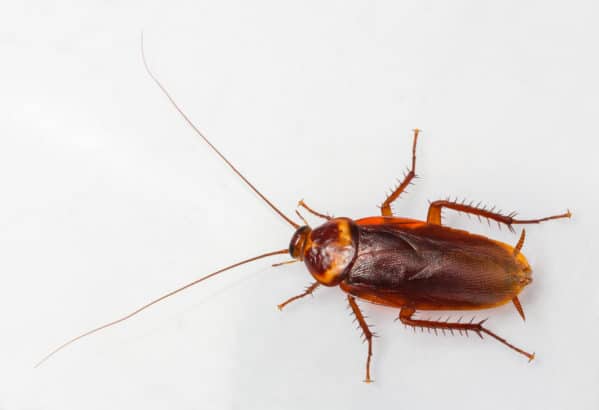American Cockroaches

These reddish-brown cockroaches average about 2.5 inches in length and have distinct yellow bands around the area behind their heads. They also have the ability to fly and can be found in homes and businesses across La Quinta and the greater Coachella Valley. American cockroaches are not water or palmetto bugs though people often get them confused. American cockroaches prefer to live outdoors in moist, humid areas such as flowerbeds or even in trees but they’ll come indoors – often into your kitchen, bathroom, or basement – to find food and water.
The German cockroach, brown-banded cockroach, oriental cockroach, American cockroach, and Turkestan cockroach are the five species of cockroaches that may be found in the state of California. Cockroaches are usually considered to be a nuisance in the house. Every species is distinguished by its own particular qualities.
Roaches, unlike many pests, do not undergo seasonal surges. They can survive in a variety of environments. That is to say, roach season lasts all year. Their ideal seasons for foraging and reproducing are the warm, damp spring and summer months. This implies that roaches have no off-season in places with warmer weather, such as California. Cockroaches are active in the spring when it is hot, as well as in the autumn when organic waste decays since they are drawn to such conditions. Even if their population numbers are reduced during the harsh winter months, they do not disappear; instead, they find ways to hibernate within your houses and structures. These relentless tiny insects are busy all year and cannot be avoided in any season!
Sightings
These active cockroaches may be seen by homeowners. American roaches can move quickly and generally flee into a dark spot. American roaches may even fly if disturbed.
Droppings
The droppings of American cockroaches are found in the dark locations where they hide. These droppings may be found in basements, pantries, and under appliances.
Because American cockroach droppings are so tiny, they are often confused for mouse droppings. The sides of American cockroach droppings feature ridges and the tips are blunt. The tips of mouse droppings are pointy. Because mice groom themselves, hairs are often embedded in mouse droppings.
Egg Capsules
The egg casings of American cockroaches are around 38 mm long. They are dark in color, either reddish or blackish brown. These egg cases are often discovered by homeowners in basements, laundry rooms, and kitchens. The egg cases might be hidden behind cupboards or behind appliances. The egg capsules of American cockroaches are frequently found beneath stored items in garages and sheds.
Odor
The American cockroach produces odorous secretions, which can alter the flavor of food, and if they’re present in a high population, you’ll be able to smell them. Cockroaches secrete a substance known as an "aggregation pheromone." Because of the stench of this chemical, the roaches congregate in bunches. Some individuals describe the odor of these pheromones as "musty." People with sensitive noses may begin to smell this stench as the roach population grows.
The number of roaches is increasing across California. Homeowners are regularly faced with the problem of cockroach infestations in their homes, garages, and yards. What causes roaches to be so prevalent in California?
According to a pest management specialist, increasing temperatures and dry conditions in the area are causing roaches that normally reside in sewage systems to make their way into houses. Interestingly, it is also considered that the relatively recent Turkestan cockroach has significantly contributed to the growing roach population in California. It's generally advisable to do everything possible to keep these pesky pests away of your house and yard.
Cockroaches are nasty pests. They have the potential to spread disease, contaminate our food, and cause allergies and even asthma attacks. As they crawl through rotting waste or sewage, cockroaches may take up germs on their legs and bodies, which they can subsequently transmit to food or onto food surfaces. They are known or suspected carriers of germs that cause diarrhea, dysentery, cholera, leprosy, plague, typhoid fever, and viral infections such as poliomyelitis, according to the World Health Organization (WHO).


